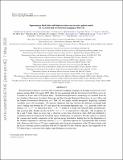Supermassive black holes with high accretion rates in active galactic nuclei. XI. Accretion disk reverberation mapping of Mrk 142
Abstract
We performed an intensive accretion disk reverberation mapping campaign on the high accretion rate active galactic nucleus Mrk 142 in early 2019. Mrk 142 was monitored with the Neil Gehrels Swift Observatory for four months in X-rays and six different UV/optical filters. Ground-based photometric monitoring was obtained from the Las Cumbres Observatory, the Liverpool Telescope, and the Dan Zowada Memorial Observatory in ugriz filters, as well as from the Yunnan Astronomical Observatory in V. Mrk 142 was highly variable throughout, displaying correlated variability across all wavelengths. We measure significant time lags between the different wavelength lightcurves. In the UV and optical, we find that the wavelength-dependent lags, τ(λ), generally follow the relation τ(λ) ∝ λ 4/3, as expected for the T ∝ R −3/4 profile of a steady-state, optically thick, geometrically thin accretion disk, though they can also be fit by τ(λ) ∝ λ 2, as expected for a slim disk. The exceptions are the u and U bands, where an excess lag is observed, as has been observed in other active galactic nuclei and attributed to continuum emission arising in the broad-line region. Furthermore, we perform a flux–flux analysis to separate the constant and variable components of the spectral energy distribution, finding that the flux dependence of the variable component is consistent with the f ν ∝ ν 1/3 spectrum expected for a geometrically thin accretion disk. Moreover, the X-ray to UV lag is significantly offset from an extrapolation of the UV/optical trend, with the X-rays showing a poorer correlation with the UV than the UV does with the optical. The magnitude of the UV/optical lags is consistent with a highly super-Eddington accretion rate.
Citation
Cackett , E M , Gelbord , J , Li , Y-R , Horne , K , Wang , J-M , Barth , A J , Bai , J-M , Bian , W-H , Carroll , R W , Du , P , Edelson , R , Goad , M R , Ho , L C , Hu , C , Khatu , V C , Luo , B , Miller , J & Yuan , Y-F 2020 , ' Supermassive black holes with high accretion rates in active galactic nuclei. XI. Accretion disk reverberation mapping of Mrk 142 ' , Astrophysical Journal , vol. 896 , no. 1 , 1 . https://doi.org/10.3847/1538-4357/ab91b5
Publication
Astrophysical Journal
Status
Peer reviewed
ISSN
0004-637XType
Journal article
Description
Funding: KH acknowledges support from UK STFC grant ST/R00824/1.Collections
Items in the St Andrews Research Repository are protected by copyright, with all rights reserved, unless otherwise indicated.

